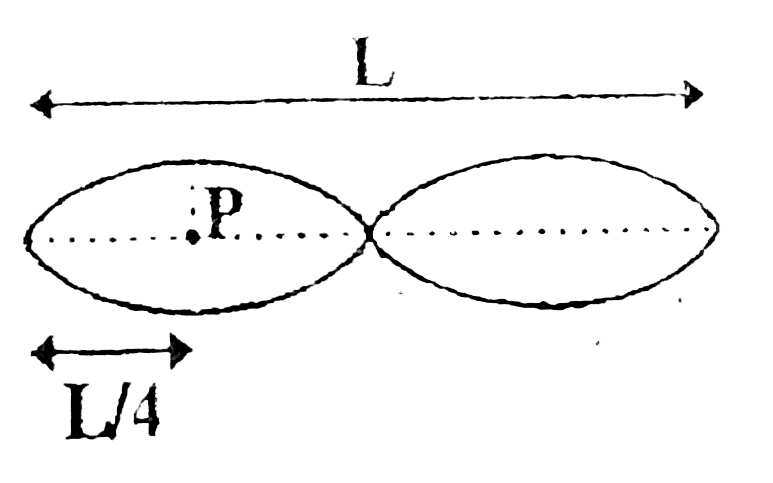A string fixed at both ends is vibrating in the lowest mode of vibration for which a point at quarter of its length from one end is a point of maximum vibration . The note emitted has a frequency of 100Hz. What will be the frequency emitted when it vibrates in the next mode such that this point is again a point of maximum vibrating ?
Since the mode has an antinode at 1/4 point
I/4=λ/4orI=λand100=cT (c=nλ)
In the next mode , between the nearest end 1/4 point from this end , there must appear one node and antinode.
∴I/4=3λ'4whereλ' is the wavelength of the next mode
⇒λ'=I/3
∴n'=cI/3=3cI=3×100=300Hz
Topper's Solved these Questions
- BOOK - CENGAGE PHYSICSCHAPTER - SUPERPOSITION AND STANDING WAVESEXERCISE - Subjective24videos
SUPERPOSITION AND STANDING WAVES
- BOOK - CENGAGE PHYSICSCHAPTER - SUPERPOSITION AND STANDING WAVESEXERCISE - Single Correct144videos
SUPERPOSITION AND STANDING WAVES
- BOOK - CENGAGE PHYSICSCHAPTER - SUPERPOSITION AND STANDING WAVESEXERCISE - Comprehension Type5videos
SUPERPOSITION AND STANDING WAVES
- BOOK - CENGAGE PHYSICSCHAPTER - SOUND WAVES AND DOPPLER EFFECTEXERCISE - Integer16videos
SOUND WAVES AND DOPPLER EFFECT
- BOOK - CENGAGE PHYSICSCHAPTER - THERMODYNAMICSEXERCISE - 241videos
THERMODYNAMICS
Similar Questions
A string fixed at both ends is vibrating in the lowest mode of vibration for whicha a point at quarter of its length from one end is a point of maximum displacement. The frequency of vibration in this mode is 100Hz. What will be the frequency amitted when it vibrates in the next higher mode such that this point is again a point of maximum displacement.
View SolutionA string fixed at both ends is vibrating such that a point at quarter of its length from one end is a point of maximum displacement. The frequency of vibration in this mode is 100Hz. If the frequency emitted when it vibrates in the next mode such that this point is again a point of maximum displacement is 100k then find the value of k.
 View Solution
View Solution
Knowledge Check
- Question 1 - Select One
A string fixed at both is vibrating in the lowest mode of vibration for which a point at quarter of its length from one end is a point of maximum displacement . The frequency of vibration emitted when it vibrates in the next mode such that this point is again a point of maximum displacement ?
A400 HzB200 HzC600 HzD300 hz - Question 2 - Select One
A string fixed at its both ends vibrates in 5 loops as shown in the figure. The number of nodes and antinodes respectively
 A5,6B6,5C7,4D4,7
A5,6B6,5C7,4D4,7 - Question 3 - Select One
A string of length l is fixed at both ends. It is vibrating in its 3rd overtone with maximum amplitude 'a'. The amplitude at a distance l/3 from one end is
AaB0C√3a2Da2
A string vibrates in 4 segments to a frequency of 400 Hz.
(a) What is its fundamental frequency?
(b) What frequency will cause it to vibrate into 7 segments?View SolutionA string of length 'l' is fixed at both ends. It is vibrating in its 3rd overtone with maximum ampltiude 'a'. The amplitude at a distance l3 from one end is =√pa2. Find p.
View SolutionA string of length L fixed at both ends vibrates in its first overtone. Then the wavelength will be
View SolutionIf a string fixed at both ends vibrates in four loops. The wavelength is 10 cm. The length of string is
View SolutionIf a string fixed at both ends, vibrates in its fourth harmonic, the wavelength is 15 cm. What is the length of the string ?
View Solution
